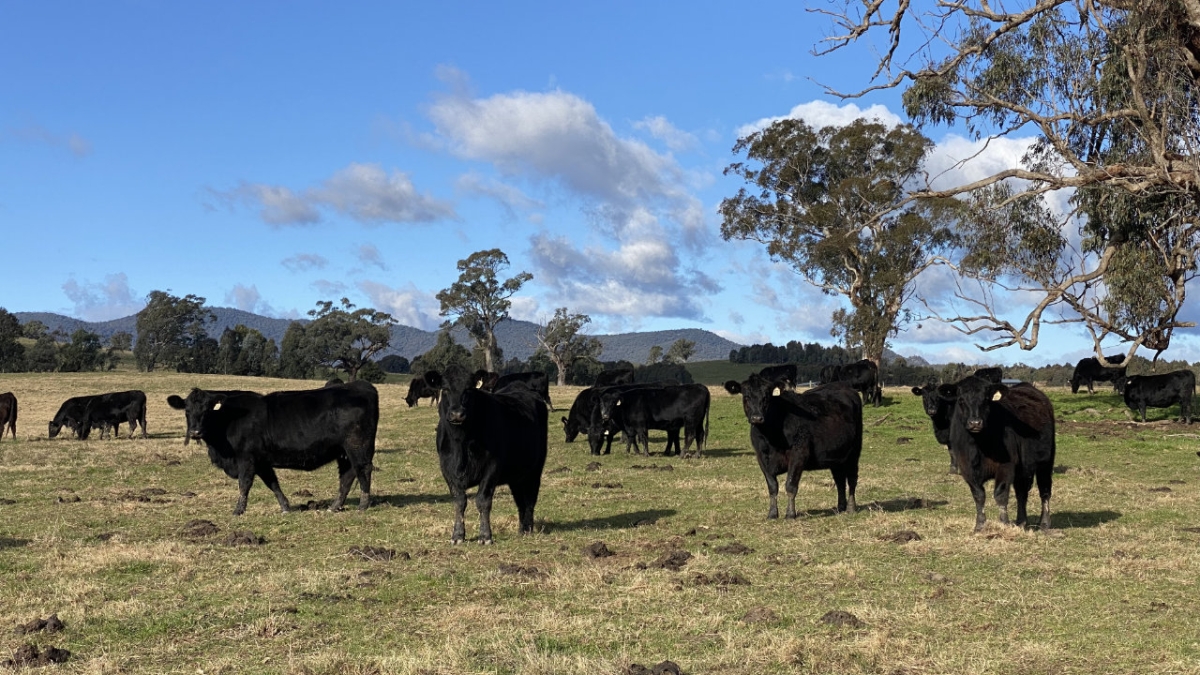The current market for cattle is at an all time high. La Niña is forecast for the third year in a row. Most old-timers are telling us we’ve never had it so good! Now is a time of surplus – both of grass and cash. Now is the time to be thinking about strategies to mitigate the impact of future ‘tougher’ times. Here are my thoughts and a virtual tour of some of the investments we’ve made to build resilience in our commercial beef enterprise in recent years.
Resilience doesn't just happen
Resilience doesn’t just happen – it takes research, planning and investment. The nearby farmer once told me: “When there’s a drought on, we are the last to know”. He was talking about the fact that most areas of the Eastern states dry out long before we do in the foothills of the Great Dividing Range. By the time we start to react, the markets have already crashed and hay is hard to buy. The problem that neighbour failed to acknowledge, was that many farmers are more inclined to ‘react’ rather than ‘pro-act’. It’s our responsibility to make sure we do know in time and that we have a plan.

When we think about our livestock businesses, there’s a bunch of factors in play. Some of the bigs ones like markets and weather are out of our control. However, many factors, such as cost of production (COP) and pasture productivity are in our control. I bet there’s more than what I’ve listed in green (above), but these are some that we’ve invested in. Some other factors like body condition score (BCS) and profit sit somewhere in the middle. It’s also worth acknowledging that some of these factors are interconnected. Sure, we don’t control the markets but we do control our COP, therefore we do have a reasonable amount of control over profit.
If we can make a profit when markets are subdued, we should be able to enjoy surplus cash when markets are good. Similarly, if we produce enough grass when seasons are tight, we should be enjoying surplus grass when seasons are good. Surpluses in the good times, whether grass or cash, allow us to reinvest in our businesses to make them more resilient when times are tough.
Resilience building projects

New Hayshed
Big deal? Everyone makes hay. This is a big deal in our enterprise because we don't feed hay in our production system. Our hay reserves are purely for drought feeding. Compared to nutrient dense feeds like grain, hay is fairly inefficient to transport. We are happy to put any quality hay away for roughage and buy in our energy and protein.

Cattle Handling
The wait times on cattle handling gear might be significant but for good reason. Operator safety is now a high priority. We went with the Te Pari set-up for the integrated EID, scales and smart drench gun. This helps us keep track of our herd on an individual basis while enabling us to process cattle much more quickly. The smart drench gun delivers the correct volume of treatment to each animal while reducing operator fatigue (think white drenches on a cold June morning).

Riparian Zone Revegetation
Sometimes a cash surplus comes in the form of a grant. I like grant opportunities because they bump projects at the bottom of to-do lists into action. Fencing off the creek had been something we wanted to do for some time. We've opted for generous setbacks from the waters edge to get a bigger area under trees. We expect this to work in our favour in the coming era of biodiversity stewardship and carbon accounting.

Water Upgrade
Without the creek for stockwater, and with some contraints around the existing reticulated system, we invested in developing a new water source and higher flow rates through existing infrastructure. Tank monitoring with Farmbots de-risks our new reliance on header tanks by allowing us to respond to water issues in a timely manner.
Pro tip: We saved ourselves quite a bit of work by connecting new 1½" poly to the legacy 1" poly line 'near' the existing troughs rather than digging up and changing all the trough fittings.

Stock Containment Areas
Stock containment areas are used to keep your stock off your vulnerable paddocks a. drought. We built these in 2008 and put them to good use in the aftermath of the Black Saturday fires a year later. They became significantly more reliable with the aforementioned reticulated water upgrade with bigger troughs and higher flow rates. These 0.7ha paddocks hold 80-100 head. We use them every year to yard wean calves, keeping them contained until we have green feed in the paddocks. They also come in useful as nursery paddocks for first calf heifers that need mothering up, and bull paddocks pre-joining.

In paddock weighing
The Optiweigh system is a triumph of tech and practical design. The concepts and hardware aren't particularly ground breaking but he delivery is smart and robust. We use the Optiweigh to watch our steers grow from weaning to 13m and book in the optimal turn-off date for the feedlot spec. We then use it to follow our heifers from joining to the mid-pregnancy to make sure they hit their targets for 95% of mature cow weight pre-calving.

Animal Health
In the recent years of cash surplus, we've spend some money to get a better understanding on our herds health profile. This has involved blood serum testing to explore mineral deficiencies, on-farm mineral supplementation trials, and post-mortems of any casualties. We've figured out that we can cost effectively treat Selenium deficiency to avoid white muscle disease and improve fertility rates. We've identified extra clostridial vaccine boosters as a cost effective way of preventing pulpy kidney deaths. We've eliminated our grass tetany losses by changing our herd to younger cows calving in Spring and using lick supplements at critical times. We've removed BVDV (pestivirus) carriers and implemented a Pestigard vaccine program. We developed a parasite management program which avoids drench resistance.

Capital Phosphorus (P)
What do you do with spare cash when interest rates are low? Invest in Phosphorus to get paddocks up to their optimal targets. We went hard and fast in on our best country to lift Colwell P from below 20 to above 40. We then settled into lower maintenance rates, bouncing around our long term target of 35. The same could be said for adding lime to increase pH. Both are long term investments that pay annual dividends of increased pasture productivity. Unlike other fertiliser treatments, P and pH don't vaporise, volatilise or leach out of the system - they're only reduced by growing grass for you.

Pasture Renovations
Firstly, don't waste money trying to renovate pastures unless you've addressed your soil fertility. Renovating pastures is expensive - especially when they fail to establish. We think we get the best results by upping fertility, cutting hay or silage to remove annual seed burden and using a winter clean-up crop of annual ryegrass. The paddock needs at least two harvests of annual seed and two chemical brown-outs before sowing a perennial grass species such as phalaris to avoid competition. We don't bother sowing sub-clover because of the already abundant seed bank. This also allows us to spray broadleaves like cape weed without worry about the impact on clover.
The biggest benefit of improved perennial pastures is early Autumn feed (existing plants grow rather than germinating from seed) and higher winter production.

Genetics
Unlike many of the other resilience building activities mentioned above, your investment in genetics should be consistent year-in/year-out. That is, don't plough surplus cash on genetics above and beyond your breeding objectives. Unlike most other farm investments, the cost of genetics is only loosely correlated to the value of genetics - the cost of genetics is largely market forces (supply and demand). A $50k bull is not 5 times better than a $10k bull. Genetics is permanent and cumulative so play the long game. Genetics will not drive short-term profitability gains. You'll make the most profitability gains with genetics by purchasing bulls that are suitable for both heifers and cows. If you've got surplus cash, buy a spare bull, and/or make sure every bull you purchase meets your breeding objectives.
Enterprise Flex
Building some flexibility into your enterprise makes it easier to adjust your program to match the seasonal conditions. For breeders, that means picking your target number for the breeding herd to be one that is sustainable in all but the worst of years. When the good seasons happen, we can increase stocking rates with young stock to capitalise on excess grass. This strategy makes it easier to make decisions when things get tough and easier to make money when times are good.

The first step in my mind is to align peak feed availability with peak nutritional requirements. In North East Victoria, our Winter/Spring rainfall is very reliable which means we want to be lactating in the Spring. We drop our stocking rate when the summer grass has run out and the cows start to lose condition. The stocking rate drops on account of weaning (stopping lactation) and selling surplus cows. Things are tightest in Winter when the pasture growth slows down but we need to be carrying enough stock to consume the following Spring flush. Our Autumns are unreliable – we’ve had above average Autumn rainfall 3 times in the last 13 years.
In the vast majority of years, we carry all our steers through the winter to consume the Spring excess, in doing so we add significant value to them. If however, we have real stinker, we can offload them as weaners. That’s how we can flex down.
On the other hand, if we happen to get a good Autumn, we can carry all our heifers through as well. They can go as a higher value item such as a feeder heifer, or if the Spring is OK, we can join them and sell surplus PTIC or MSA grass-fed. This is how we flex up.
With the work we’ve done on pasture fertility and perenniality in recent years we’ve actually lifted our stocking rate from 14 DSE to 19 DSE – not with more cows – but by constantly carrying all weaners through to higher value animals as described above. This has increased our profitability without increasing our exposure to seasonal risk.
Young Stock vs Mature Breeders

- Young stock provide an opportunity to value-add as you grow them out.
- Cows are less flexible to flex with due to their reproductive cycle. Reducing cow numbers results in less calves.
- A system with high heifer retention rates outputs high value PTIC mature cows.
- A herd of all breeders uses 75% of all grass grown in maintenance rather than production.
- The major source of enteric methane emissions in a breeding herd is in maintaining the cow. You can improve your emissions intensity by running more young stock.
- In a Spring calving system, we can flex with our own weaners. In an Autumn calving system, trading cattle is an option.

